在这篇文章中,英国建筑师,Timothy Brittain-Catlin博士介绍了Space Popular的工作,一种探索在建筑设计过程中运用虚拟现实技术背后的意义与方法的新兴实践。
译文:
建筑正在进入一个历史与媒介同样重要的领域
建筑实践,正高速地朝着历史与媒介同样重要地领域发展,尤其是在英国。建筑师工作的方式已经完全不同于过去,这就产生了一个根本性的冲突:使用虚拟现实技术的设计,在实践中如何利用历史?在飞速的早期发展里,我们都意识到我们可以用一种特殊方式向顾客展示我们的作品,让一个甚至不了解计划的人也可以理解。我们可以从三个维度和不同的角度来建立细节,甚至是展现一天中的不同时间。但是,接下来呢?我们要如何将历史知识和建筑经验融入进去呢?
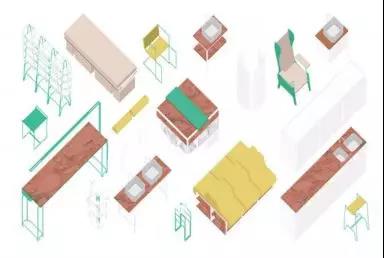
正是这个问题催生了Space Popular,一个由建筑联盟(Architectural Assiciation,AA)毕业生Fredrik Hellberg和Lara Lesmes在2013年建立的伦敦实践基地。他们工作的方式与大多数年轻建筑师的方式都不一样,比如,他们不设计小的物体,尽管他们的工作室在2015年为曼谷的无限水疗中心(Infinite SPA)生产了一种精致的迷你绿色钢椅,那是到目前为止他们完成的最著名的项目。同他们的同龄人一样,他们面临着激烈的竞争;而迄今为止,真正让他们的工作变得有规划的是他们在建筑领域里面对虚拟现实的挑战和潜力的特别方式——从中创造一些新的东西,可以代表建筑师们所寻求的经验的分层。
Lesmes做出了这样的解释:建筑完全可以脱离尚未被解决的问题,单独被感受。至今,虚拟现实倾向于遵循一个简单的模式:根据实际情况所得的参数,用这种或者那种形式设计建筑,然后你创造虚拟现实来展示或者再定义结果。但是,Lesmes还说,你也可以从经验出发回到建筑上;这是一件你以前并没有真正做过的事情,在任何层面上都没有:这就是Space Popular正在建立的视角。
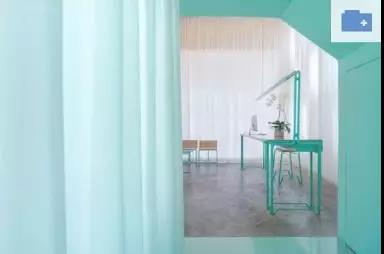

Glass Chain,伦敦·克莱肯维尔·斯托维尔斯塔特的一个展览,展示了他们将走向何方。展出中心是一个面对着StoVentec玻璃的高高的屏幕,钢化玻璃面板上印着彩色陶瓷,被固定在一个纸板上。这个大约3米高的面板整个被装饰成色彩缤纷的建筑物形式,包括塔楼、楼梯、拱廊、粗糙石块,和一些用水晶做成的哥特式建筑形式(狗牙装饰和其他类似的东西)。Hellberg说,这个模型的比例大概是1:100。也就是说,建筑实物大概有300米高。事实上,StoVentec面板是平的,尽管它有了不得的亮点。但在展会上举行的特别活动中,参观者可以带上HTC的头戴视图器,看到面板的三维展示,比如:平面台阶突然向后弹,形成一个嵌在墙内的礼堂。(非常有意思的是,有着工艺背景的Hellberg,作为瑞典工艺和设计协会YNG的创始人兼执行董事,也从未见过这样“平面”的建筑装饰。)
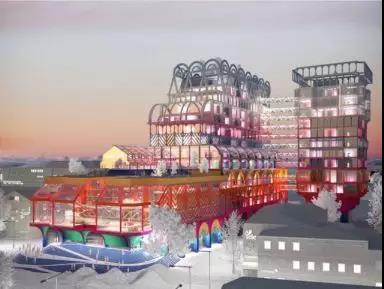
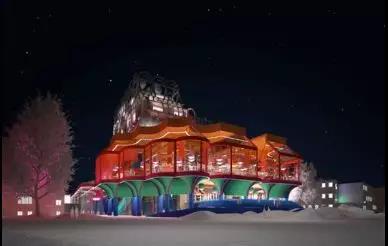
其中的意义在于:从此,戴着VR头戴视图器看到的虚拟建筑,简直同你用手触摸到的玻璃面板上的一样真实。还有其他方面,特别是取决于时间的这些装置。可能Space Popular最让人熟知的是他们充满活力的印花棉布墙壁挂衣架:今年早些时候,悬挂在伦敦英国皇家建筑师协会(RIBA)的佛罗伦萨大厅中心的巨大吊顶。事实上,去年建筑协会(AA)的圣诞晚会的布景是由位于贝德福德广场(Bedford Square)的学校场地的立面组成的。他们的部分想法是,要与一个特定的场合联系在一起被看到,而许多细节的象征意义仅仅只与那一刻有关。因此,Space Popular设计并制造适合在特定场合佩戴的装配也就不足为奇了。Lesmes说,那些体验过这些的人才能最终把事件联系起来,增加他们的经历;最后,反过来明白其中的意义。2014年,他们提出过这样的早期安装,作为Amy Croft和Adam Nathaniel Furman的作品《如何看待建筑展》的一部分。(Hellberg说,Furman是他的建筑教父。)
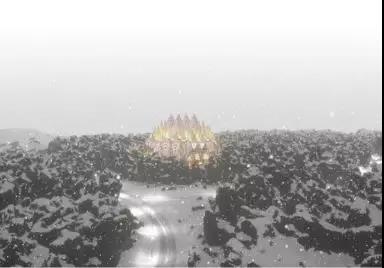
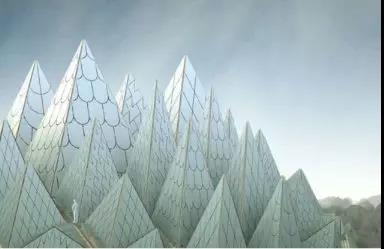
Space Popular所采用的历史元素对于他们整个方案来说是很基础的,Lesmes以这样一段话总结了我们的对话:“我们研究过去发生的事情,创造再进行反复的调整,使它变成新的东西。”想来,Gottfried Semper也非常赞同这样的想法。
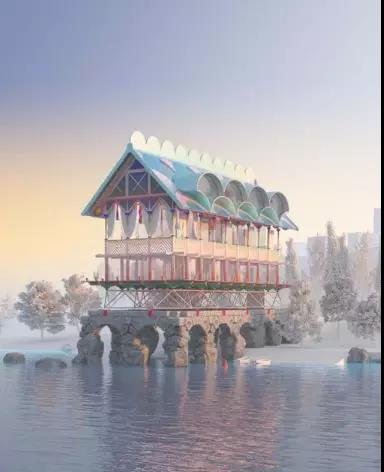
原文:
Architectural practice, especially in the UK, is moving fast into a realm where history plays as much a part as medium. But the ways in which architects work have been transformed entirely from those of the past, generating a fundamental conflict: how in practice does design through virtual reality use history? In the earliest days of fly-throughs we all realized that we could show our work to clients in a way that even the least plan-literate could understand. We could develop details three-dimensionally and from different angles, even representing different times of day. But what next? How do we engage historical knowledge and experience of buildings?
This was the question that launched Space Popular, a London-based practice established by Architectural Association (AA) graduates Fredrik Hellberg and Lara Lesmes in 2013. They spend their time differently from most young architects; they don’t, for example, design small objects, although their studio sports one of the fine mint-green steel chairs they produced for the Infinity Spa in Bangkok in 2015, their best known completed project to date. Like many others of their generation (and before and since), they have entered a large number of competitions. But what has marked out their work so far is the remarkable way in which they have confronted the challenges and potential of virtual reality in architecture head on – to make something new from it that represents the layering of experiences that many architects seek.
Lesmes explains it like this: architecture can be experienced entirely separately from the problem solving that goes on behind the scenes. Virtual reality to date has tended to follow a simple pattern: you design the building in one form or another, according to the parameters thrown up by the situation, and then you create the virtual reality to demonstrate, perhaps refine, the results. But, Lesmes says, you can also start from the experience and work backwards to the building. This is the one thing you couldn’t really do before, at any rate not to the same extent; and this is the aspect of it that Space Popular is now developing.
The Glass Chain, an exhibition at Sto Werkstatt in London's Clerkenwell, demonstrates where they are going with this. Its centrepiece is a tall screen faced with StoVentec glass – that is, a toughened glass panel printed with coloured ceramic inks and fixed over insulation to a carrier board. The whole of one face of the panel, about three metres high, has been decorated in a riotous collage of architectural forms in vivid colours that includes towers, stairs, arcades, rusticated blocks, and crystalline forms in somewhat gothic forms – dogtooth mouldings and the like. The scale, says Hellberg, is about 1:100. That means that it represents a building about 300 metres high. Of course the StoVentec panel is flat, although it has a luxuriant sparkle to it. But at special events held at the exhibition, visitors can don HTC headsets and see a three-dimensional representation of it: the flat steps suddenly pop backwards to form an auditorium buried within the wall, for example. (It is interesting to note that Hellberg comes from a craft background, as the founder and director of YNG, the Swedish Society for Crafts and Design, and has never seen architectural ornament as a ‘flat’ thing.)
The point of this is that the virtual building seen with the VR headset is therefore as real an experience as the glass panel you can touch. And there are other aspects too, notably the fact that these installations are time-dependent. Space Popular are perhaps best known for their vibrant printed cotton wall hangings: a huge one hung from the centre of the Florence Hall at the Royal Institute of British Architects (RIBA) in London earlier this year. These too are highly detailed, made up from architectural elements. In fact, a set made for the Architectural Association’s (AA) Christmas Party last year was composed of elements from the facades of the school’s premises in Bedford Square. Part of the point of them was that they were to be seen and associated with a specific occasion, and that much of the symbolism of the details in these sheets (which were wrapped around columns to form a kind of hypostyle) was related to that moment only. It comes as no surprise therefore that Space Popular have designed and made kimonos that are to be worn for specific occasions; then—as Lesmes says—the people who experience these artefacts associate them afterwards with that event, adding to the experience of them and, in turn, their significance. They presented an early installation like this in 2014 as part of Amy Croft and Adam Nathaniel Furman’s Re.presence: How to See Architecture exhibition: Furman is his architectural ‘godfather’, Hellberg has said.
In fact, Hellberg and Lesmes explain that the origins of many of these ideas came from their friends at the AA. Hellberg’s fourth-year unit master was Oliver Domeisen, who introduced them specifically to the work of Gottfried Semper, an architect never usually mentioned in British architectural education because of the dominance there of the gothic revival. The traditional critique of Semper is of his distinction between the structural and the non-structural. But Domeisen saw that once the designer is liberated altogether from the notion of the structural—those practical parameters behind every conventional scheme—then it becomes possible to explore Semper’s ideas about the ornamented construction of surfaces in a much freer way. The 19th Century ideas that interested Domeisen were echoed in the history courses that Hellberg attended: I was one of the lecturers, but the other was Benny O’Looney, who is fondly remembered by students everywhere for his knowledge of and enthusiasm for London buildings. These things together gave us the language to talk about and develop the imagery in our own designs, says Hellberg: the historical elements meant something and were not just a string of anecdotes.
The historical elements that Space Popular have adopted are fundamental to their whole approach. Lesmes concludes our conversation by saying: "We study things that happen in the past. We draw something and redraw it, and it becomes something new." Which is, of course, a message that Gottfried Semper would have approved of.
文章来源:译自《Architecture Is Moving Into a Realm Where History Plays as Much a Part as Medium》
